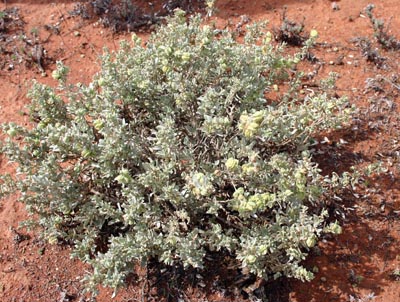|
Atriplex
vesicaria
bladder saltbush
The bladder saltbush is one of the large group of Chenopods
found throughout Fowlers Gap and indeed Australia. The bladder saltbush
is quite common on Fowlers Gap, occuring pretty much without favour throughout
the Station amongst the rest of the Chenpods.
Bladder saltbushes are erect or sprawling dioecious
shrubs, up to about 1 m high. They get their name from the small bladder
that forms as part of the fruit. There are 8 named subspecies of this
plant.
Bark: stems are glabrous to woolly.
Leaves: 5-25 x 3-15 mm, more or less elliptic with a short stalk,
usually entire, scaly grey-green, rather thick.
Flowers: female flowers occur in small axillary
clusters. Male flowers are more numerous and occur in long spikes of small
flowers.
Fruit: have 2 rounded "wings" 8-15 mm diameter with bladder
appendages covering part or all of bracteoles
or joined below or absent. Bladders are thin-walled, partly inflated and
variously shaped and sizd depending on the subspecies.
Source: Frank Kutsche and Brendan Lay (2003). Field guide to
the plants of outback South Australia. Department of Water, Land and
Biodiversity Conservation, South Australia, ISBN 0 7590 1052 8.
Phillip Moore (2005). A guide to plants of inland Australia. Reed
New Holland, ISBN 1 876334 86 X.
Photos: Ian Roach
Back
|

 |







